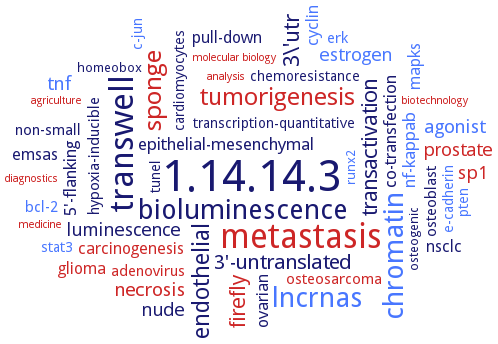1.14.14.3: bacterial luciferase
This is an abbreviated version!
For detailed information about bacterial luciferase, go to the full flat file.

Word Map on EC 1.14.14.3 
-
1.14.14.3
-
metastasis
-
transwell
-
bioluminescence
-
chromatin
-
lncrnas
-
sponge
-
tumorigenesis
-
endothelial
-
3\'utr
-
transactivation
-
firefly
-
3'-untranslated
-
necrosis
-
agonist
-
tnf
-
prostate
-
estrogen
-
sp1
-
luminescence
-
nude
-
nf-kappab
-
5'-flanking
-
epithelial-mesenchymal
-
co-transfection
-
cyclin
-
glioma
-
nsclc
-
emsas
-
ovarian
-
carcinogenesis
-
mapks
-
pull-down
-
hypoxia-inducible
-
osteoblast
-
erk
-
non-small
-
bcl-2
-
adenovirus
-
osteosarcoma
-
chemoresistance
-
stat3
-
pten
-
c-jun
-
tunel
-
e-cadherin
-
cardiomyocytes
-
transcription-quantitative
-
runx2
-
osteogenic
-
homeobox
-
biotechnology
-
agriculture
-
diagnostics
-
medicine
-
molecular biology
-
analysis
- 1.14.14.3
- metastasis
-
transwell
-
bioluminescence
- chromatin
- lncrnas
- sponge
- tumorigenesis
- endothelial
-
3\'utr
-
transactivation
- firefly
-
3'-untranslated
- necrosis
- agonist
- tnf
- prostate
- estrogen
- sp1
-
luminescence
-
nude
- nf-kappab
-
5'-flanking
-
epithelial-mesenchymal
-
co-transfection
- cyclin
- glioma
-
nsclc
-
emsas
- ovarian
- carcinogenesis
- mapks
-
pull-down
-
hypoxia-inducible
- osteoblast
- erk
-
non-small
- bcl-2
- adenovirus
- osteosarcoma
-
chemoresistance
- stat3
- pten
- c-jun
-
tunel
- e-cadherin
- cardiomyocytes
-
transcription-quantitative
- runx2
-
osteogenic
-
homeobox
- biotechnology
- agriculture
- diagnostics
- medicine
- molecular biology
- analysis
Reaction
Synonyms
4a-hydroperoxy-4a,5-dihydroFMN intermediate luciferase, aldehyde monooxygenase, alkanal monooxygenase (FMN), bacterial luciferase, COB, Gluc luciferase, HFOOH, luciferase, Lux, LuxA, LuxAB, LuxB, LuxCDABE, LuxF, Vibrio fischeri luciferase, Vibrio harveyi luciferase
ECTree
Advanced search results
Inhibitors
Inhibitors on EC 1.14.14.3 - bacterial luciferase
Please wait a moment until all data is loaded. This message will disappear when all data is loaded.
5-decyl-4a-hydroxy-4a,5-dihydroriboflavin-5'-phosphate
-
binding and fluorescence quantum yield studies of the substance as a model, complexed with the enzyme in a 1:1 molcular ratio leading to 80% and 90% inhibition of wild-type and mutant C106A at 0.01 mM, respectively, binds to the active site
6-(3'-(R)-myristyl) flavin adenine mononucleotide
binds noncovalently to the enzyme dimer. Addition of recombinant apo-LuxF captures myrFMN and thereby relieves the inhibitory effect
dodecanamide
-
inhibits bacterial luciferase luminescence reaction. By injecting the dodecaneamide into the bacterial luciferase system, the luminescence intensity decreases to about half of the initial intensity
fullerenol
-
fullerenols suppress bioluminescent intensity at concentrations above 0.01 g/l and above 0.001 g/l for C60O2-4(OH)20-24 and Fe0.5C60(OH)xOy, respectively
methanol
-
bacterial luciferase luminescence intensity decreases to the steady state depending on the methanol concentration
potassium iodide
-
quenches the fluorescence of FMN effectively at 0.2 M, and enhances the decay of wild-type and HFOOH enzymes, the wild-type enzyme forms an inactive complex with KI
8-Anilino-1-naphthalenesulfonate
-
inhibitor binding site separate from FMN-binding site by 30 A
-
reversible substrate inhibition, depending on phosphate concentration
-
1-hexanol does not inhibit the enzyme luminescence
-
additional information
-
hydrophobicity of the quinone plays a role in the non-specific inhibition mechanism of xenobiotic molecules in the bacterial bioluminescence system via altering the rotational mobility of the endogenous flavin in the luciferase. Added quinone reduces the averaged binding affinity of the endogenous FMN to the active site of luciferase by increasing the fraction of the weak FMN binding sites of luciferase
-
additional information
-
luxA mutant and luxB mutant strains are more sensitive to oxidants like H2O2, cumene hydroperoxide, tert-butyl hydroperoxide, or ferrous sulfate, than the wild-type strain, growth behaviour overview
-
additional information
-
increases in oxygen concentration lead to gradual decreases of the peak bioluminescence intensity, Km for FMN, and Km for NADPH of NADPH-specific flavin reductase in the coupled reaction with luciferase
-


 results (
results ( results (
results ( top
top






